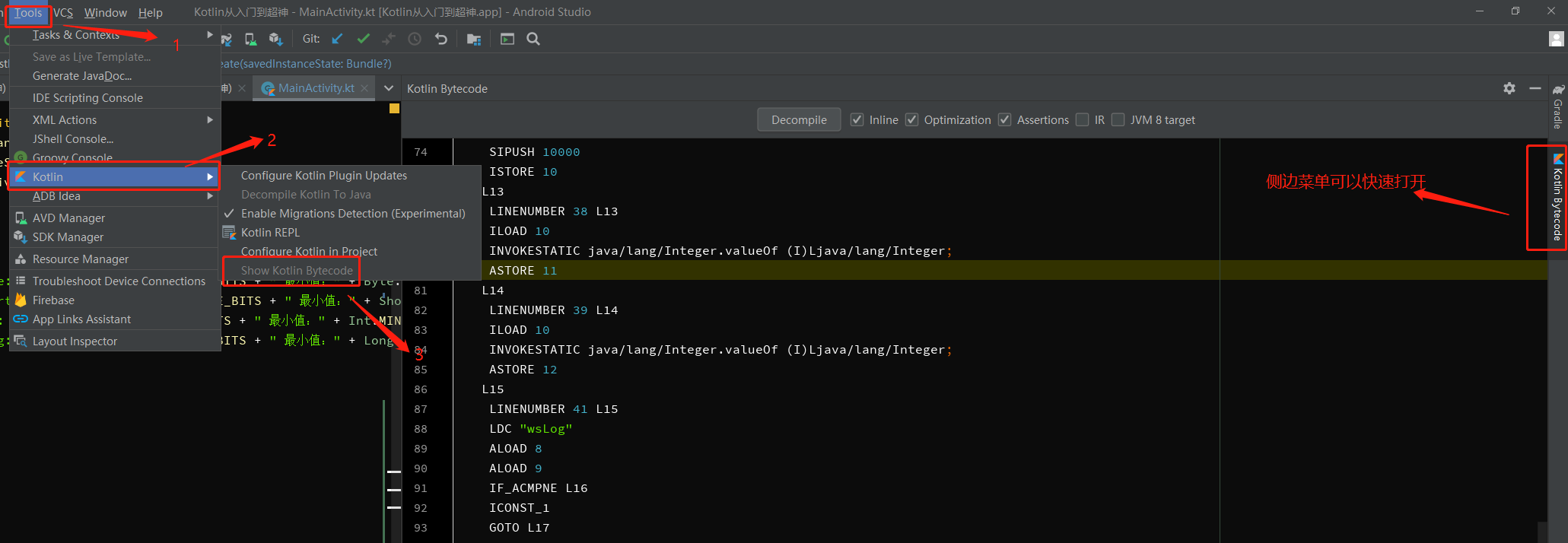- 疑惑
怎么理解kotlin官方文档一下一段话
在 Java 平台数字是物理存储为 JVM 的原生类型,除非我们需要一个可空的引用(如 Int?)或泛型。 后者情况下会把数字装箱。
注意数字装箱不一定保留同一性:
val a: Int = 100
val boxedA: Int? = a
val anotherBoxedA: Int? = a
val b: Int = 10000
val boxedB: Int? = b
val anotherBoxedB: Int? = b
println(boxedA === anotherBoxedA) // true
println(boxedB === anotherBoxedB) // false
从代码中,我们关注到只是数字不一样,为啥有两种结果?
- 探索过程
1.按一下步骤打开Kotlin Bytecode

2.从kotlin翻译成字节码中,我们可以看出kotlin对数字装箱

3. 不管数值是100还是10000,都调用了Integer.valueOf ()
INVOKESTATIC java/lang/Integer.valueOf (I)Ljava/lang/Integer;
4.我们走进Integer.valueOf()源码看究竟
/**
* Returns an {@code Integer} instance representing the specified
* {@code int} value. If a new {@code Integer} instance is not
* required, this method should generally be used in preference to
* the constructor {@link #Integer(int)}, as this method is likely
* to yield significantly better space and time performance by
* caching frequently requested values.
*
* This method will always cache values in the range -128 to 127,
* inclusive, and may cache other values outside of this range.
*
* @param i an {@code int} value.
* @return an {@code Integer} instance representing {@code i}.
* @since 1.5
*/
public static Integer valueOf(int i) {
if (i >= IntegerCache.low && i <= IntegerCache.high)
return IntegerCache.cache[i + (-IntegerCache.low)];
return new Integer(i);
}
private static class IntegerCache {
static final int low = -128;
static final int high;
static final Integer cache[];
static {
// high value may be configured by property
int h = 127;
String integerCacheHighPropValue =
sun.misc.VM.getSavedProperty("java.lang.Integer.IntegerCache.high");
if (integerCacheHighPropValue != null) {
try {
int i = parseInt(integerCacheHighPropValue);
i = Math.max(i, 127);
// Maximum array size is Integer.MAX_VALUE
h = Math.min(i, Integer.MAX_VALUE - (-low) -1);
} catch( NumberFormatException nfe) {
// If the property cannot be parsed into an int, ignore it.
}
}
high = h;
cache = new Integer[(high - low) + 1];
int j = low;
for(int k = 0; k < cache.length; k++)
cache[k] = new Integer(j++);
// range [-128, 127] must be interned (JLS7 5.1.7)
assert IntegerCache.high >= 127;
}
private IntegerCache() {}
}
从源码看出当i在[-128,127]区间,会从IntegerCache.cache中获取,在该区间之外会new Integer()对象,从而导致引用不一致。
最后
以上就是愤怒向日葵最近收集整理的关于如何理解kotlin数字装箱的全部内容,更多相关如何理解kotlin数字装箱内容请搜索靠谱客的其他文章。
本图文内容来源于网友提供,作为学习参考使用,或来自网络收集整理,版权属于原作者所有。








发表评论 取消回复